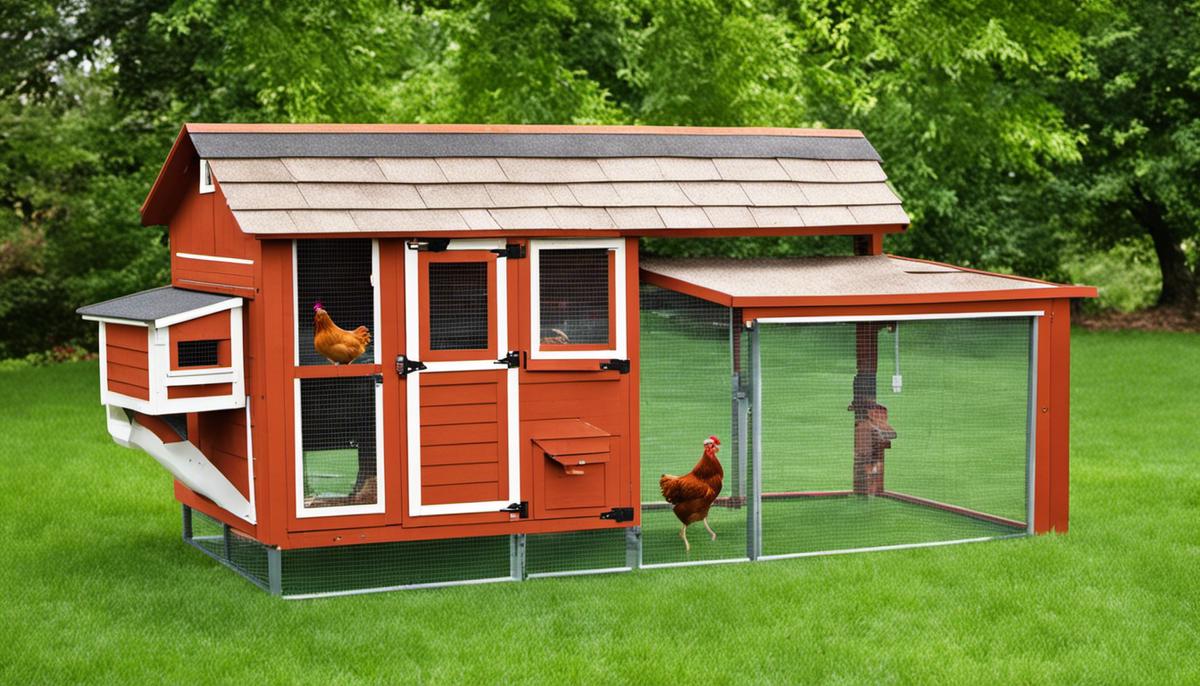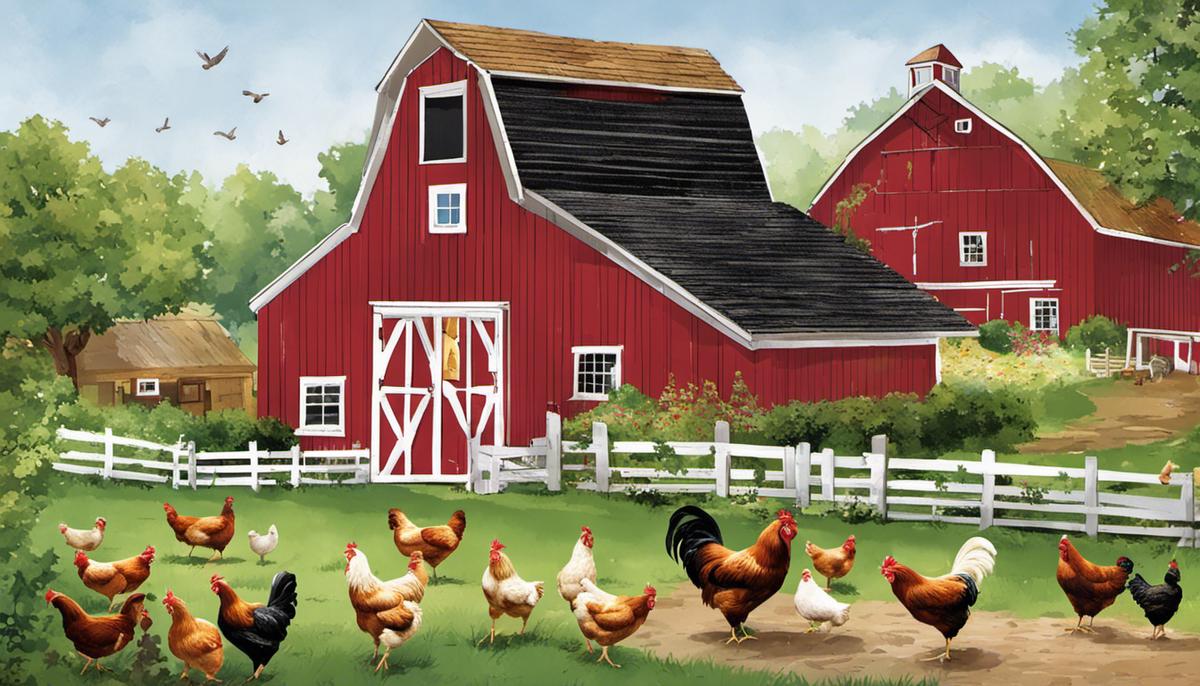An understanding of chicken behavior and their needs is instrumental in raising them effectively. Whether it involves understanding the space requirements for nesting and socializing or considering chicken breeds and their unique needs, being well-informed about optimizing chicken coop space and how many chickens to keep can remarkably boost the health and productivity of your chickens. As backyard poultry farming grows in popularity, it is prudent to also familiarize oneself with local regulations regarding chicken rearing. This will ensure you stay within the legal boundaries of your local laws while ensuring your chickens have the appropriate conditions for growth.
The design of the chicken coop plays a significant role in addressing the behavioral and physiological needs of chickens, and hence, delving into elements such as ventilation, insulation, and accessibility becomes essential.
To understand more about building your own chicken run, check out my DIY Guide: Building your own Chicken Run.
We will receive a commission if you purchase through our affiliate link at no extra cost to you. Please read our disclosure policy for more information.
Understanding Chicken Behavior and Needs
Understanding Chicken Behavior
Chickens are complex animals with unique behaviors that require individual comprehension for proper care and housing. Primarily, they are social creatures that thrive in flocks, engage in dust bathing and forage for food. Therefore, while planning housing for your chickens, it’s crucial to provide enough space for them to display these natural behaviors.
Space Requirement for Nesting
For your chickens to lay eggs in a healthy and comfortable environment, each hen requires at least 1 square foot of nesting space. This will provide them with a secluded and secure area which is essential for laying. The standard size for nesting boxes is usually 12 inches wide, 12 inches deep, and 12 inches high. You also need to provide one nest box for every 3-4 hens since they often lay eggs at different times.
Here is an example of nesting boxes on the side of the coop
The bungalow chicken coop allows a second add-on nesting box section.
Feeding Space Requirements
For feeding space, each chicken should ideally have about 4 inches of feeder space so they can eat without feeling crowded. This would mean a 4-foot feeder can serve about 12 chickens. Also, provide clean water at all times in a spot that won’t be easily tipped over by the active birds.
Room for Movement
Chicken coops should provide ample room for the birds to move around, stretch their wings, and engage in social activities. It is generally accepted that each chicken should have a minimum of 4 square feet of space inside the coop, but 8 to 10 square feet per bird is optimal.
Free Space for Socializing
Chickens love to roam, scratch and forage around, so having outdoor space or a run is very beneficial. Each chicken will need an additional 10 square feet in the run. This also gives chickens the space they need to avoid conflict with each other, reducing stress and enhancing their overall well-being.
Meeting Physiological Needs
Moreover, Chickens require some degree of sunlight as well as shade. The coop should provide sufficient ventilation to maintain their respiratory health and keep temperatures down in hot weather. Remember to periodically check that there is no dampness as well, as this can lead to health issues.
In summary, understanding the behavioral and physiological needs of your chickens, including their space needs for nesting, feeding, moving and socializing, is fundamental in ensuring their health and productivity. Adequate knowledge and application of these needs can contribute to a more productive and prosperous flock.

Designing the Chicken Coop
Understanding Chicken Coop Dynamics
For raising healthy, happy chickens, understanding the layout and dynamics of a chicken coop is crucial. Remember, a good design promotes ventilation, insulation, and accessibility, as these factors significantly impact the welfare of your birds.
Ventilation is essential as chickens produce a significant amount of dust and ammonia in their droppings, which could lead to respiratory disease if not well-ventilated. Similarly, heat and humidity might pave the way for disease and discomfort. Your chicken coop needs to have sufficient vents or windows to allow fresh air to come in and circulate. Insulation, on the other hand, is vital in cold climates to maintain ideal temperatures for the chickens.
Here is a link to a great book all about building Fresh air chicken coops, its and oldie, but a good book.
Accessibility should also be a priority. The chicken coop should be designed such that cleaning, feeding, and collecting eggs are simple tasks. Install doors and hatches intelligently to facilitate easy access.
Opting For Right Chicken Coop Materials
Different materials can offer specific benefits for your chicken coop. The primary options available include wood, metal, and plastic.
Wood is a preferred choice since it is a natural resource, proves to be sturdy, and offers good insulation. While choosing wood, prefer hardwood over softwood for durability. Conversely, metal coops are lightweight and easy-to-assemble though they may not provide the best insulation. Plastic coops are the easiest to clean and are often highly portable and weather-resistant. However, they might not offer the same level of insulation as their wooden counterparts.
There are many designs on the market today, some have the option of being mobile, one unique looking coop is the Nestera Wagon Coop.

Size Matters: Calculating The Ideal Chicken Coop Size
How many chickens to keep depends on the size of a chicken coop, this is a factor that can’t be overlooked. Chickens need their space to roam, peck, and rest comfortably. As a general rule, each chicken would require about 2-3 square feet inside the coop and about 8-10 square feet in an outdoor run area. However, the breed and size of the chicken can affect these dimensions, so it’s essential to do your research.
For example, if you plan to keep ten chickens, your coop must have at least 20-30 square feet of space inside and 80-100 square feet outside. Overcrowding can lead to hygiene issues and aggressive behavior among chickens.
Optimizing The Interior Design
The interior of your chicken coop needs to be planned meticulously to meet the needs of your chickens. Basics elements to include are perches for your chickens to roost on, nesting boxes for egg-laying, and adequate space to walk and feed.
Remember, chickens prefer to perch at the highest available spot. So, design your coop such that the perch bars are higher than the nesting boxes to avoid chickens roosting in them. It’s recommended you provide 8-10 inches of perch space per chicken. Nesting boxes should ideally be provided at the ratio of one box for every four to five hens. Lastly, ensure the feeder is placed in a way it doesn’t hinder the walking space but is accessible for feeding.
Taking good care of these attributes can result in a healthy living condition for your chickens, leading to better egg production and happier birds overall.

Local Regulations on Keeping Chickens
Understanding Local Regulations
In deciding to raise chickens, examining your local ordinances is the first crucial step to understanding how many chickens you can legally keep, and in what manner you can house them. To do this, you’ll want to visit your municipality’s website or office and ask for the zoning regulations for backyard poultry. Look specifically for details related to keeping livestock in residential areas.
Ordinances and Zoning Laws
Local laws typically cover aspects such as coop size, the number of hens you can keep, the allowed distance of the coop from property lines, and often, whether you are allowed to keep roosters due to noise concerns. Some municipalities regulate coop sizes to restrict the number of birds and manage waste that could accumulate. Take careful note of these points, because even unknowingly breaking these rules could bear hefty fines.
Coop Size and Chicken Health
Size regulations for chicken coops usually tie in with maintaining the health of the flock. Chickens need space for foraging and exercise, so a tiny, cramped coop could affect their health and egg production. As a general rule, each chicken you keep should have at least 10 square feet of coop and run space. Remember your chickens need room to run, review my guide to building your own chicken run.
Chicken Quantity and Noise Management
Though the law may allow you to keep a certain number of chickens, squeeze in as many as you can within that limit isn’t necessarily the best idea. Hens can get noisy especially when laying eggs. Too many hens in a small area might disturb your neighbors, so be considerate about noise management.
Waste Management Practices
Local rules can also cover how to manage chicken waste. Effective waste management benefits you, your neighbors and the chickens. Fresh chicken waste makes excellent compost, but improperly handled, it can pose a nuisance, and even a health risk. Ideally, you should clean coop runs daily and do a deep clean of the coop every month. Check if your local laws specify any handling or disposal methods for poultry waste, too.
Coop Construction Standards
Some areas also govern the construction requirements for chicken coops. Depending on your local laws, you may require a permit to build your coop. Usual regulations cover the quality of construction, the use of predator deterrents, and sometimes, the aesthetics of the coop. Always remember to consider the comfort and safety of your chickens when designing your coop. Stick to any instructions related to the coop’s size, height, capacity, or the materials used.
By taking the time to understand and follow local laws and guidelines, you will minimize any negative impact on your neighbors, and maximize the health and happiness of your flock.

Chicken Breeds and their Space Requirements
Know Your Breed
Understanding the specific needs of various chicken breeds is crucial when considering how many chickens you can have in a coop. Different breeds have diverse space requirements, a factor that can make a difference in their health, productivity, and overall happiness. For instance, larger birds like Orpingtons and Jersey Giants will need more space compared to smaller breeds like Bantams.
For a guide on choosing the breed of chicken you are thinking about raising, consider reading my article on: Choosing the ideal breed for your chicken farm
Housing Needs of Chickens
Typically, the recommended minimum space for a chicken in a coop is about 3 to 4 square feet per bird. However, if they don’t have access to an outdoor run, you would want to provide 8 to 10 square feet per chicken within the coop. For outdoor space, a general rule of thumb is to allow for 10 to 20 square feet per bird, though some larger or more active breeds may require more space.
Understanding the Impact of Space on Chickens
Adequate space is important for the health and wellness of your chickens. Overcrowding can lead to stress, disease, and disruption in your flock’s pecking order. Stress can decrease egg production, increase aggression, and make chickens more prone to illness. Always ensure optimal space for your chickens for their continuous egg-laying, foraging, and social activities.
Factoring in Breeds’ Temperament
The temperament of your chosen breed is another important consideration. Some breeds, such as Rhode Island Reds and Leghorns, may be more active and require a larger run to roam, while others like Silkies are known for being calm and could manage with less space.
Researching Specific Breeds
Ensure you conduct thorough research on the specific needs of your selected chicken breeds prior to setting up a coop. This will involve understanding the size and nature of various breeds, their food preferences, and optimal conditions required for their growth.
Adjusting for Breeds and Their Traits
Each breed may require different adjustments to your coop setup. For example, breeds that prefer roosting high might require more vertical space, while those that are heavy may need more sturdy perches. Understanding these traits will help you optimize your coop design.
Adjustments may also include the required coop temperature, type and amount of bedding needed, perch and nesting box requirements, and predator protection measures.
Tailoring your coop set-up based on your bird’s breed will ensure a stress-free and productive environment for your chickens.

After all the deductions made, ensuring your chickens’ health and productivity all comes down to understanding their behavior, needs, and the regulations set by your locality. Selecting a chicken breed that conforms to your resources and preferences is a pivotal stage of the process. Additionally, the way you design your chicken coop can make a momentous difference in the life of your chickens. Remember that the coop needs to conform to the size and personality of your breed, providing ample room for activities like nesting, feeding, and socializing. So, let’s raise happy, healthy chickens by creating an environment that respects their natural needs and adheres to local laws, ultimately leading to plentiful and productive poultry farming.
For More information on keeping a health flock, check out.
The Essential Checklist for Keeping Your Flock Healthy








